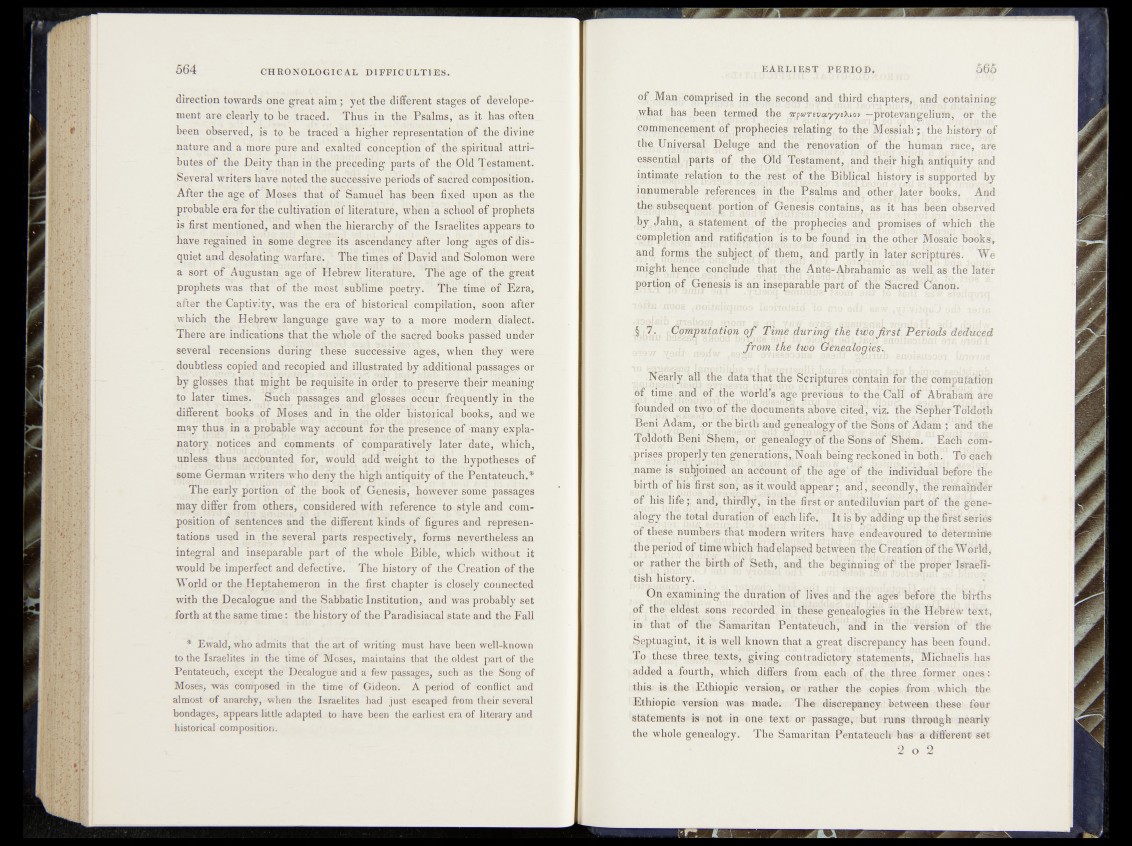
direction towards one great aim ; yet the different stages of develope-
ment are clearly to be traced. Thus in the Psalms» as it has often
been observed, is to be traced a higher representation of the divine
nature and a more pure and exaltea conception of thé spiritual attributes
of the Deity th^n in fee, preceding parts of the Did Testament.
Several writers have noted the successive periods of sacred composition.
After the age of Moses that of Samuel has been fixed upon as the
probable era for the cultivation‘óf literature, wneh 'a school of prophets
is first mentioned, and when the hierarchy of the Israelites appears to
have regained in some degree its ascendancy after long ages óf disquiet
and desolating warfare;^ The times of,David and Solomon were
a sort of Augustan age of Hebrew literature. Tneàgé of the great
prophets was that of the móst'sublime poetry. The time 'of Ezra,
after tbmOaptivity, was the era of historical compilation, soon after
which. the Hebrew language gave way to a more modern dialect.
There are indications that the whole of the sacjed books ‘passed under
several recensions during these successive ages, when they' were
doubtless copied and recopied and illustrated by additional passages or
by glosses that might he requisite in order, to preserve their meaning
to later times. Such passages and glosses occur, frequently in the
different books of Moses and in thé older historical boohs, and we
may thus, in a probable way aeeOuntfpI the présence.of-many explanatory
notices and comments of comparatively later date, which,
unless thus accounted for, would add weight to the hypotheses of
some German writers who deny the high antiquity of the Pentateuch.*
The early portion of .the book of. Genesis, however some passages
may differ from others, considered with reference tpxstyle and composition
of sentences and the different kinds of figures and representations
used in the several parts respectively, forms nevertheless an
integral and inseparable part of the whole Bible, which without it
would be imperfect and defective. The history of the Creation of the
World or the Heptahemeron in the first chapter is closely connected
with the Decalogue and the Sabbatic Institution, and was probably set
forth at the same time : the history of the Paradisiacal state and the Fall
* Ewald, who admits that the art of writing must have been well-known
to the Israelites in the time of Moses, maintains that the oldest part of the
Pentateuch, except the Decalogue and a few passages, such as the Song of
Moses, was composed in the time of Gideon. A period of conflict and
almost of anarchy, when the Israelites had just escaped from their several
bondages, appears little adapted to have been the earliest era of literary and
historical composition.
óf Man comprised in the> second and third chapters,, and Containing
what has been termed the vpajrsva.'yyeXiov —protevangelium, or thé
commencement of prophecies relating to the Messiah; the history of
.the. Universal Deluge and the renovation of the human race, are
essential parts of the Old Testament, and their high antiquity and
intimate ^platiqnn tq tli^ .rëfet of the Biblical history ié supported by
inpumerable referencest itt xhe Psalms and other. later hooks. And
Genesm. contains, as it has héén observed
by Jahn, a statement of the prophecies and promises of which thfe
c.bpRle|iön and ratification is to be found in the other Mosaic Books,
anjl forms, tjie subject Af them, and partly in later spripturés. ,We
.haight, hence conclude that the. Ante-Abrahamic as wellf as tne latêr
^rtmp of GeSeais is an inseparahle part of thèSacrédffanon.
4 ht;E. oj^Thmduring f deduced
from , the two Gineal<igies^
a n in fe S S f j the ocriixtures crajteffirfer
btj time, and of ..the World’s age previous to the, Call of Abrahanl are
fotmaeu on tW of the .qoca^neiita. above cited, v^|, fhe li e f e r Toldiihh
BaM A^n^,- mr the birth and genealogy of the Sons of Adam ; ' arid the
Toidoth Beni Shorn, or geneafogyvof the Sons of Bhem. “ Each ctfin-
iPrises properly ten gehejationLl^oah being rechoned m'hotb.^ To each
nrnne is' shlpoiaed an account of, the age* of the individual before the
birth of his first son; as it,would appear; anff'^ecbflmj/thpr^aihder
of his life ;? and, thirdly, in the first 07 antediluvian part of the gbDe-
a^0B7 total duration of each life.,.. It is by adding up the first sCrife
of these, numbers that modern writers have endeavoured to deterrniiJe
the period of time which had elapsed between the Creation of the World,
or rather the birth of Seth, and the beginning of1 the prCperlsraeli-
tish history.
On examining the duration of lives and the ages before the births
of the eldest sons recorded in these genealogies in the Hebrew text-,
in that of the Samaritan Pentateuch, and in the version of the
Septuagint, it is well known that a great discrepancy has been found.
To these three, texts, giving contradictory statement, Michaelis has
added a fourth, which differs from eachofcthe jthrge^former. opes-:
this is the Ethiopie version, or rather the ,copies whiqh: the
Ethiopia version was- made; The discrepancy between these- four
statements is not in one text- 01* passage, but runs through neasrly
the whole genealogy. The Samaritan Pentateuch' has a different set
2 o 2